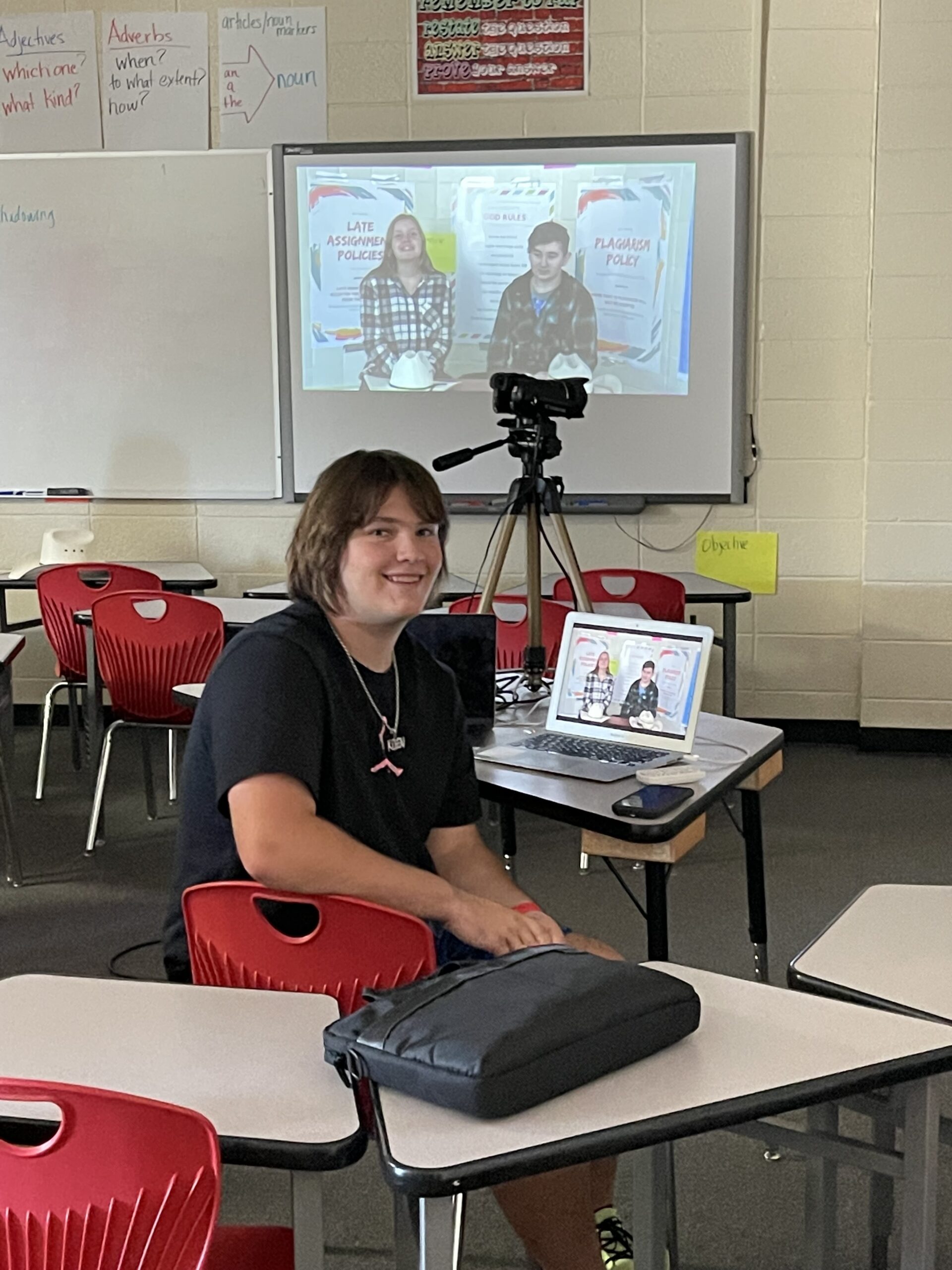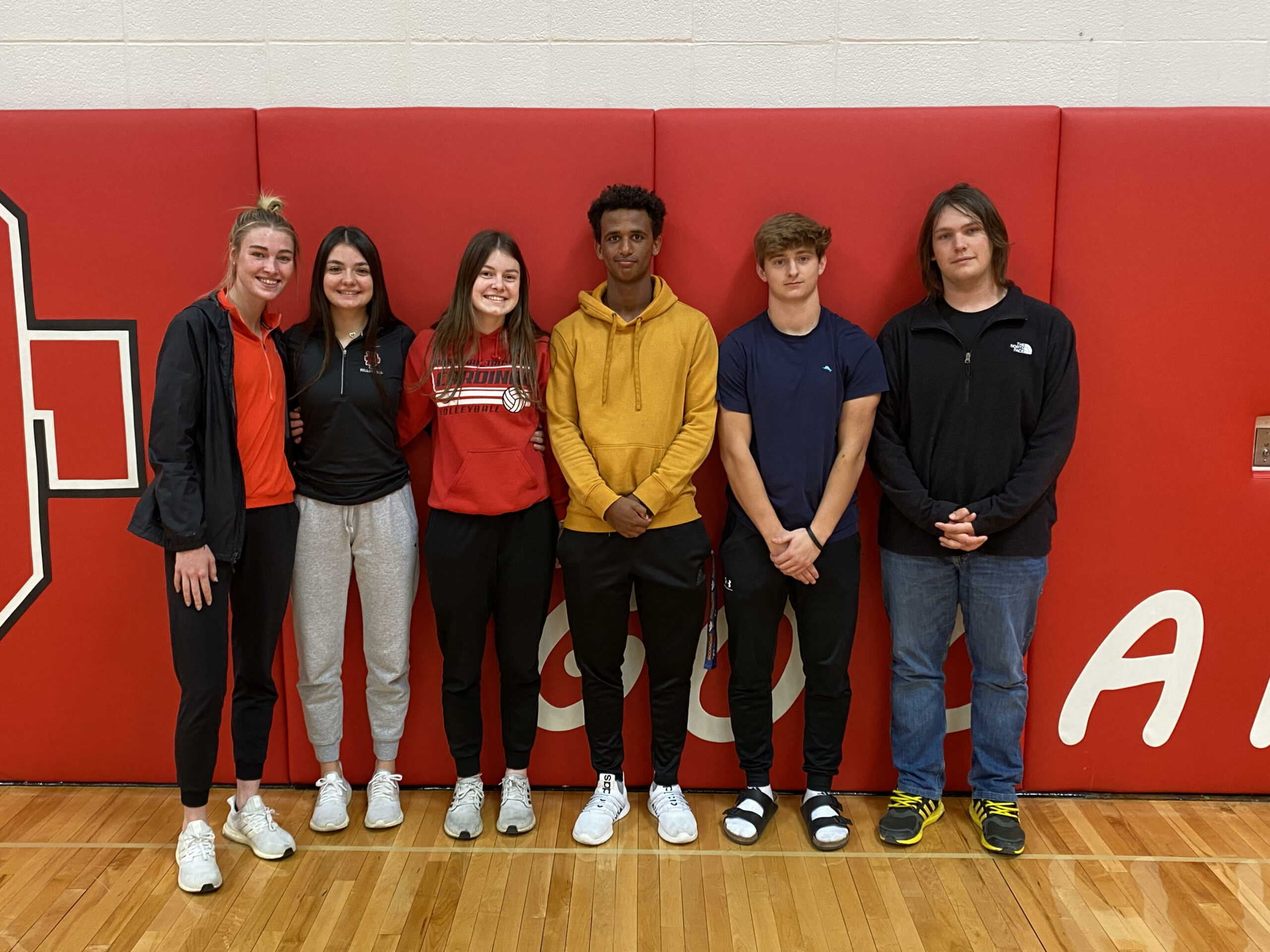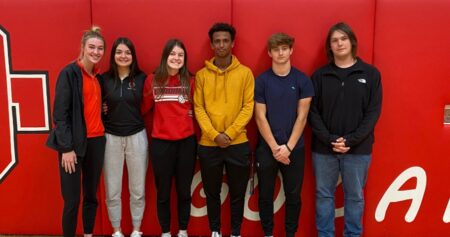Doniphan is a small, central-Nebraska community about an hour and half west of Lincoln, the state’s capital. It’s a straight shot down interstate 80, exit 318, then a peaceful drive through waving squares of colorful farmland. You’d hardly know you had arrived if not for the modest welcome sign. Preserving the Good Life, it reads, in big bold letters–a nod to the state’s long-standing tagline. No stop lights or Walmarts, Doniphan is home to about 800 people. The “Trumbull” in Doniphan-Trumbull is an even smaller nearby community of just over 200 people–a village according to census classification. At the center of town is Doniphan-Trumbull Public School–as if the whole community just settled in around it. And, if you ask Principal Michaela Goracke, it basically has: “These are two really great communities that lend a lot of support for our school district,” she says. “We’re very fortunate to have so much support.” Rallying and highlighting that support is an ongoing and multifaceted effort–one that’s reinforced by an innovative approach to its digital media class and, particularly, social media.

Engaging Online
In the beginning, DT’s social presence was minimal. Like a lot of schools, staff struggled to find time to collect photos, write posts, and schedule content. Michaela–a lifelong educator new to her role as an administrator–approached it practically.
“My goal was one image or post every day showing what’s going on in the building,” she says. Despite her best efforts, Michaela struggled to keep up. “My life is so busy every day that it maybe happened twice a week. I just didn’t have the time to dedicate to it.” In addition to being pulled in many different directions by a wide range of priorities, it’s also especially difficult for a teacher (or administrator like Michaela) to be physically present at all the activities and experiences happening across a school’s ecosystem.

For many schools, social media is sporadic, generally neglected, or, in the case of Doniphan-Trumbull, it becomes a place to post clerical announcements and logistics updates. “It really became more of us just posting the information that needed to get out, not the moments and experiences happening in our classrooms and between our students and staff–the content that would be ideal,” says Michaela.
And then there was student Koen Johnson–a sophomore at the time. “He’s that kid who pitches in and helps out with all things technology,” explains Michaela. “He does our livestream network setups, helps connect audio and microphones, troubleshoots computer problems. I’m always looking for opportunities to get him more and more exposure to technology and the things that interest him,” she explains, noting that it had been a struggle. “He kept telling me that he wanted to do technology, photography, and digital media stuff–they all interested him. So much so that he wanted to go to another school… one that could provide those opportunities.”
“That was breaking my heart,” adds Michaela. “I want our schools to keep those kids here and serve them well. So I was wracking my brain.”
Michaela’s voice has a smile behind it. “Koen immediately reached out about the job. He wanted it. He said, ‘Ms. Goracke, what do I have to do?’”
“I had never thought about having a student do it,” admits Michaela, who went to her superintendent to discuss the possibility. “I called him and I said: ‘Hey, I’ve got a crazy idea for you.’”
It was about that time that Michaela heard about Class Intercom, a social media management tool built specifically for schools and–as luck would have it–designed for use by both staff and students. In fact, the edtech company’s approach is all about integrating social media and content creation into the student experience–effectively involving students and staff in actually creating content for their school’s social media. The platform allows for that involvement to be intentional and constructive, so it leads to not only great stories and social content, but huge learning and growth opportunities for students.
For Michaela, it was the perfect solution: “It was absolutely beautiful timing.”
Building a Team of Content Creators
With its superintendent’s support and Koen on board, Doniphan-Trumbull Schools set out to build a team of content creators. The summer heading into Koen’s junior year, the school created a digital media class, implementing Class Intercom’s technical framework for managing secure access to the school’s social media accounts, content drafts and collaboration, and approval workflows for posts to Facebook, Instagram, Twitter, and LinkedIn.
Through the platform, schools connect their social media channels and pages–whether that’s a simple page for a high school in the Midwest, or a more complex nesting of pages that includes separate handles for a district’s buildings and their subsequently grouped athletics programs, departments, activities, and even the school mascot. An unlimited number of student users can be added to the platform with customizable access permissions so they can capture and submit content for review by designated moderators on an ongoing basis. All those pages and users roll up into an easy-to-use dashboard, making it easy for moderators to review content as it’s sourced from students and staff across school groups and activities.
The onboarding of a school or district like DT is simple and straightforward. Accounts are connected, moderators are added and provided access permissions, and everyone is trained. Students also get onboarded, working through certifications to ensure they have a baseline understanding of the platform and creating compelling content, along with the responsibility of contributing to community-facing pages that represent their school.
With the platform in place and the class assembled, Michaela and her team got to work hammering out some early logistics and style guidelines to get things moving in the right direction. “We had to consider consistency and cohesion,” explains Michaela. “So we made some decisions about how we wanted to show things. We wanted there to be some themes that carried through all our posts. For example, we always say Doniphan and Trumbull–never just one. And we have some specifics about how colors are used for the high school versus the primary school.”

The first semester was eventful for DT students, and we have many memories to look back on, like the time the Social Media Team watched the Class Intercom sponsors present tips on making a post more entertaining.
????: Kaleah Olson, DT Journalism#DTjournalism#DTcards pic.twitter.com/e83eUMSRvC— Doniphan-Trumbull Public Schools (@DTCardinals) December 28, 2022
Michaela also incorporated copywriting, photography, design, and other skills into the coursework, providing students hands-on, on-the-ground experience at events and activities. “The team at Class Intercom helped a lot,” notes Michaela. “I worked closely with Dr. Jill and her team and picked their brains quite a bit. We had the kids make digital media badges that they would wear to games like press passes. They were the ones taking pictures and posting.”
Through the platform, students could draft, edit, schedule, and submit content for review. Moderators (including teachers and administrators like Michaela) manage these inbound posts seamlessly–from a desktop or mobile device–inputting feedback within a specific post and sending it back to the creator for revisions as needed.
“We also worked on getting the kids to go back and double-check their work, making sure they have the right dates and times on posts and that there are no errors,” adds Michaela, noting the importance of having a moderation tool designed with this kind of collaborative, experiential learning in mind. Once approved, posts automatically publish to the designated channels at the scheduled date and time.
By the time fall rolled around, the class was off to a good start and eager to attend the Content Generation Workshop (Class Intercom’s annual student event) by way of a school-sponsored trip to the company’s headquarters in downtown Lincoln, Nebraska. The team attended alongside hundreds of other in-person and virtual students and teachers from schools all over the country. Presenters and workshop leaders discussed everything from interview strategies to engagement amid broader conversations about career opportunities in media, marketing, writing, journalism, design, and related fields.
“We learned even more about planning and organization–things like using consistent color schemes and styles,” says Michaela. “But it was also just great for the kids to have an opportunity to pick up new strategies for finding and telling great stories about the world around them.”

Empowering Students & Staff
These days, social media management at DT Schools is a well-oiled machine spearheaded by the digital media class. At the beginning of the semester, Michaela provides a printout from the schools’ calendars detailing every school-related activity. “Our digital media class divvies out who is creating what content for what activity, sport, or school function. Then they use the skills they’ve learned in class to create posts that are published to our school social media channels through Class Intercom. The classroom teacher and all the admins have access to moderation. I don’t want to say we take turns as moderators, but if a post is added and we get to it, then we just jump in and make sure everything is good to go before approving.”
DT has also made an intentional effort to be inclusive and representative of its student population by capturing content across a wide range of groups and activities. In addition to the kids who take the digital media class, each group within the school has a designated social media representative. “So, for example, FCCLA, FBLA, the football team–any group can have a representative and we give them a Class Intercom account so they can contribute in a secure and meaningful way,” explains Michaela. “They’re then responsible for posting about their organization or group. That puts some responsibility on the kids to provide some coverage of those different areas, and then when the kids get to post to the public forum–it gives them a chance to show off their work.”
“I really like seeing my work published on our school social media,” he says. “It’s really cool to see the graphics I made and everyone commenting on them.”
As for Koen, he’s now heading into his senior year; though he didn’t quite get the job he applied for, he agrees. “I really like seeing my work published on our school social media,” he says. “It’s really cool to see the graphics I made and everyone commenting on them.” There’s also the technology component, and the exposure he’s getting to new tools, platforms, and equipment.
“I’m really interested in the graphic design and photography side of things,” he says, adding that working on DT’s social media has encouraged him to explore those passions further. “For my birthday I wanted a camera, so I bought myself one and started taking pictures. Then I got more into editing photos and doing graphic design. The graphic design part was new, so I was then able to get into Photoshop and learn it, too.”
Beyond the Classroom
Empowering students and staff through hands-on learning is precisely the goal for Class Intercom. In fact, the platform is backed by five core pillars of pedagogy: storytelling, skillbuilding, student voice, digital citizenship, and community. Students like Koen are invited to use and refine their skills and passions to tell important stories about the people and world around them.
For DT, this kind of storytelling positions the inspiring things happening daily in classrooms front and center for community members in a way that humanizes the students and schools, but also invites the community’s engagement and support.
That support comes in both big ways and seemingly small ways, notes Michaela. “On Labor Day, the students wrote thank you notes to all the businesses and delivered them,” explains Michaela. “We recently had two co-opted softball games and we had a ton of people come out to the home game and support.”
Indeed, the relationship between Doniphan-Trumbull Schools and its community is a uniquely symbiotic one powered by goodwill. “I’m just so thankful for what they do to support us,” she adds. “And it’s not just the businesses, it’s our community partners, and the people who live in Doniphan and Trumbull. Our community is just so great and so supportive. I don’t want to use the word overwhelming…” She pauses, a bit awestruck. “It’s awesome,” she says with finality.
Your DT Social Media Team traveled to ESU9 in Hastings to learn more about enhancing their online skills. The team was just motivated by the speaker, Dante Boelhower. We plan to keep learning more to entertain you guys❗️????#TheCardinalWay #WeAreDT #DanteBoelhower #esu9 pic.twitter.com/YAH02uTMzX
— Doniphan-Trumbull Public Schools (@DTCardinals) January 31, 2023
Along the way, students and staff learn about community building and true digital citizenship. The platform, then, acts as more than a social media management software for schools–but a unique learning environment and a truly authentic assessment tool that allows students and staff to put the skills and experiences they’re learning into practice.
A Surprisingly Innovative Approach
For Doniphan-Trumbull’s students and admins, the student-led social media adds up to hands-on learning powered by student agency and accountability. “I think there’s some ownership for them in their school,” reflects Michaela. “They take pride in the work they’re doing.”
In fact, the launch of student-led social media at Doniphan-Trumbull has provided opportunities for both Michaela and Koen to present on the school’s innovative approach. “Koen has presented at a regional conference for our state’s teaching association on some of the work he’s doing, and I recently gave a presentation about some of our work-based and internship-based learning where I talked about our media class,” explains Michaela.
“Another principal reached out and explained that she was having a hard time because her superintendent won’t let the kids near social media. He was concerned about giving them free rein. I was like: ‘Woah, wait. We gave them the keys, but we’re still driving.’ We talked about Class Intercom and how they’re creating content, but we still control and moderate it,” she adds. “It’s just an incredibly powerful tool for students, staff, and schools.”
“There’s some ownership for [the students] in their school. They take pride in the work they’re doing.”
Interested in learning more about using technology to empower students and staff to leverage social media at your school? Follow the link below to learn more about how Class Intercom can help.
